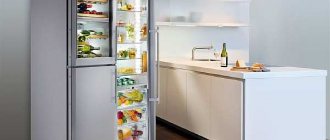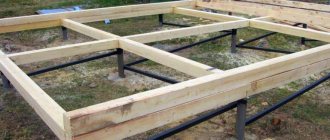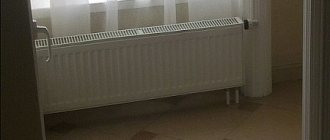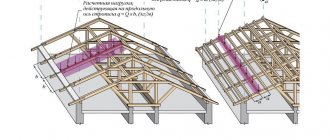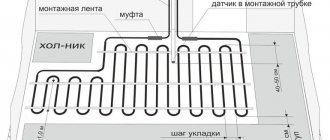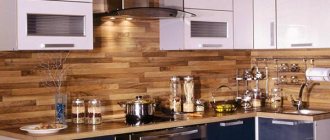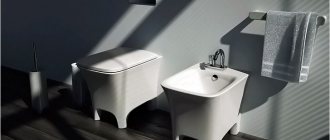The minimum distance from the toilet to the wall is a parameter determined by SNiP 2.08.01-89 “Residential Buildings”. SNiP are building codes and regulations developed back in Soviet times. But the distance from the wall to the toilet is not just the distance dictated by SNiP or GOST, because there are some standards in the production of building parts and plumbing equipment. These are documented optimal parameters obtained in a reliable way.
Toilet in the toilet
Dimensions and distances
To make visiting the bathroom comfortable, it is important to adhere to certain standards for the height of the installed toilet and the optimal distance between plumbing fixtures.
One of the most important indicators is the distance from the wall. If the toilet and bath are separate, then it is worth considering the following standards:
- The room intended for the toilet must be at least 0.8 * 1.2 m.
- The height of the bowl of the product must be at least 40 cm, while the height of the barrel is 81.5 cm, and the height of the drain pipe is 18.5 cm.
- If a bidet or washbasin is also installed in the room, the distance from the extreme point on the bowl to the middle axis of the bidet bowl should be at least 38 cm; the ideal distance is considered to be 45 cm.
- The distance between the wall and the middle axis of the bowl is at least 40 cm; for maximum comfort, it is recommended to install the product at a distance of 45 cm.
- For comfortable use, maintain at least 60-65 cm of free space in front of the product.
For a mixed bathroom, it is important to consider the location of all plumbing. For maximum convenience when using the bathroom, the minimum gap between its elements:
- The distance between the toilet and the sink is at least 20 cm.
- Ideally, the distance from the shower or bathtub should be at least 90 cm.
- From the toilet to the bidet - 30 cm.
In addition, when remodeling a bathroom, you need to place the plumbing fixtures at a distance from the riser that is suitable for its optimal operation. Increasing the distance between the pipes and the toilet can cause the water seal to fail.
Standard toilet sizes
Depending on the type of structure, it may have different dimensions:
- Floor. The compact toilet, which has a special shelf for the tank, has dimensions: Length - 610-645 mm; Bowl (width) - 345 and more; Height 370-395 mm. Plumbing without a shelf: Length - 435-460 mm; Width - 360 mm; height - 355-390mm.
- Suspension. Length - 470-700 mm; Width - 355-375 mm; height - max. 395 mm. In this case, the installation height can be adjusted independently.
- For children. Its length is 460-550 mm; width - 290-320 mm; height - 260-350 mm.
How to rationally equip a bathroom
In a modern home, be it a standard apartment or a private house, there is always both a bathroom and a toilet room, or a combined version of them. In most cases, they are not too large, but it is quite possible to allocate the necessary space for a sanitary area and a bathing area. Before purchasing plumbing fixtures, you need to measure the area of the room and determine the locations for the sink, bathtub and other equipment, taking into account the recommended rules and regulations for their installation.
It is recommended to install the bidet next to the toilet, at a distance of at least 60 cm.
When organizing space in the bathroom, you should take into account ergonomics and observe rational placement. It is necessary to determine in advance and accurately the maximum comfortable distance between the toilet and the bidet. There are no clear regulations on the size of this distance; its choice is quite arbitrary, but it must be taken into account that the distance from the sewer riser to the toilet is 1 m, and the rest of the plumbing is placed no further than 3 m.
It is advisable to make the free distance in front of each device at least 60 cm (an area of 70x100 cm will be more convenient), and on each side you need to leave 25-30 cm. The direct distance between the bidet and the toilet, according to the advice of experts, can be made from 30 cm to 45 cm A shorter distance will not be enough to use plumbing, and a larger distance will not be very convenient. From the appliances to the washbasin, if it is provided in a sanitary area, there is a gap of at least 25 cm.
Installation dimensions
Depending on the model and manufacturer of the product, its dimensions will also change. If you are planning another bathroom remodel in the future, it is recommended to install a toilet with an oblique projection. This will make it more mobile. In addition, to avoid difficulties, you must adhere to the following standards:
- If you have chosen a device with a horizontal outlet and started installing the toilet, then there should be a distance of 18 cm from the floor to the sewer outlet, and 20 cm for an oblique outlet.
- The dimensions of the opening for installing a toilet are also important. From the sides from the structure to the wall, at least 30 cm is maintained.
- The water pipe should be at a minimum distance for comfortable connection of a flexible hose to the tank.
Classification of toilets by type of installation
This product can also be divided into two categories, depending on the installation method: floor-standing and hanging. Floor-mounted ones, in turn, are divided into subcategories: wall-mounted and simple.
Floor-standing
This is the most common type of toilet. It is characterized by ease of installation and low cost. Typically, floor-mounted structures are installed in a more or less spacious room; for a room with a small area, a wall-mounted option (compact flush system) is more suitable.
Installing plumbing fixtures using anchor bolts does not require much time. The advantage of this type is that the floor covering does not suffer during installation.
Hanging
This type of toilet is installed in small rooms and saves a lot of space. The toilet mount can withstand a load of up to 400 kg, but there are models that can withstand more.
When installing, the device bowl is attached directly to the wall, at a certain distance from the floor. It is secured using either a frame or block method. To save space, sometimes such a toilet is installed in a special niche in the wall.
Calculation of toilet dimensions
Before installing plumbing fixtures, you need to choose a model that is suitable in size. It is recommended to focus on the largest family member and choose the appropriate option. If he is comfortable, everyone else will be comfortable using it too.
Which flooring to choose
For the ergonomics of the bathroom, it is very important to choose the right flooring.
The floor should not be slippery, as this can lead to accidents. The main types of materials used in bathrooms and toilets are:
Tiles in the toilet
- Non-slip ceramic tiles;
- Laminate;
- Linoleum.
You need to choose very carefully. It should have a slightly rough structure so that it does not slip when wet. Typically, Italian ceramic tiles are of much higher quality than domestic ones and have a longer service life. Tile flooring has many advantages:
- This coating is abrasion-resistant and can be washed and cleaned without fear;
- Moisture resistance;
- Durability;
- Beautiful appearance.
There is only one drawback - ceramic tiles are afraid of mechanical damage; you cannot drop various objects on them, as they can deteriorate irrevocably.
By choosing laminate for your bath, you get a beautiful floor covering that can imitate expensive wood. Even a novice master can install laminate in a bathroom, the main thing is to fit the joints well. If the joints are poorly fitted, then moisture can get into them and the laminate will be deformed and damaged. It is advisable to lay special mats on top of the laminate; such a coating becomes slippery when exposed to water.
Linoleum bathroom
You can lay linoleum in the bathroom. This flooring is inexpensive, beautiful, is not afraid of moisture, and is easy to lay on the floor. However, when wet, linoleum is very slippery, so it is also necessary to use special bathroom mats.
Heated floors in bathrooms have proven themselves well, this is especially true for combined toilets with a bathtub. Such floors are pleasant to walk on with bare feet and do not require an additional source of heating in the room.
We won’t teach you how to “pull apart the walls”, but we will tell you how to properly manage the available space
PROBLEM 1: It’s uncomfortable to wash
Place the bathtub against a short wall
If the length of the short wall of the bathroom is 160 cm or more, it is more logical to place the bath along it. With this arrangement, you will not only have a comfortable bathroom, but even an elongated rectangular bathroom will seem more proportional.
Fact:
Placing a bathtub along the long wall of a narrow room is not the best option. The room will seem like a pencil case.
PROBLEM 2:
It is difficult for an elderly person to get in and out.
Hang handrails
A safe, ergonomic and comfortable bathroom is unthinkable without grab bars to help you get out of the bathtub or shower. They are needed primarily in the bathrooms of apartments where elderly people or children live. It is convenient to place such a handrail at the waist level of the user standing in the bathtub: for a person of average height this is approximately 100 cm.
Find a barrel bath
It is believed that if there is no space for a bath, you need a cabin, and it can be organized in any area. In fact, this is “self-deception”: you can wash comfortably in a 90 cm font (pictured), the question is what kind it is. The same is true with a shower stall: you can arrange it even in a small space, but it will be inconvenient to wash in a cabin measuring less than 90 cm. What is better: installing a bathtub or a cabin if there is not enough space - everyone decides for himself.
PROBLEM 3: Distance in front of the toilet
For typical small-sized housing, this is a pressing issue: the toilet space is so small that, sitting on the toilet seat, you rest your head against the door. Is it possible to somehow increase the distance from the toilet to the door without remodeling by adding a hallway? Yes, but it all depends on your plans for renovation.
Find a compact toilet
If you have a typical separate toilet and do not intend to combine it with a bathroom, consider replacing the toilet. The distance from the toilet to the wall with the riser depends on two factors: the dimensions of the model and the type of its outlet (the angle of attachment of the pipe with the riser). If you find the same monoblock, but with a seat of less depth, you will gain 5–7 cm. Sometimes this is critical.
Warm floor
They can be either electric or flexible pipes with hot water. The connection and control panels for the electric floors are placed in front of the door to the bathroom.
Toilets
There are floor-standing ones with a tank (compacts), floor-standing ones with a built-in tank, hanging ones, and also combined with a bidet. Wall hung toilets require additional space to install the flush cistern into the wall.
| Optimal dimensions of a floor-standing toilet | Optimal washbasin sizes |
Bidet
There are floor and hanging ones. It is better to buy complete with a toilet, to maintain the style and shape of the same design (in wall-hung kits, all communications must be hidden under one panel). The bidet is installed next to the toilet at a distance of 15-20 cm.
Sinks
There are ceramic, glass, steel, acrylic, stone and wood. According to the type of fastening, they are divided into console sinks attached to the wall with brackets, standing on a stand (tulip type) and built-in sinks. The standard sink depth is 45 cm. The length of double sinks is 120-150 cm. The distance between the sink and the shower cabin is or the bathroom must be at least 30 cm.
| Necessary optimal sizes for washing in the bathroom |
| Necessary optimal dimensions for towel drying in the bathroom |
Baths
There is a wide variety of bathtubs made from different materials: Cast iron. They heat up quickly and retain heat for a long time. Such baths are not subject to corrosion. The only limitation is the design; there are no other shapes other than rectangular. Steel. Durable surface, but does not hold heat well. Acrylic (plastic). Such baths are durable, but do not retain heat. They come in a variety of shapes and sizes. Quarilic (a mixture of acrylic with quartz powder). Holds heat well, durable and scratch resistant. There are also Wooden, Onyx, Marble and Steel bathtubs. In terms of functionality, there are regular and hydromassage bathtubs. The choice of bathtub depends on the size of the bathroom. There is a direct relationship between the height and length of the bathtubs - the longer they are, the lower their height. Common bathtub sizes are 170x70 cm. There are also sitz bathtubs with lengths of 150x70 and 120x70 cm.
| Standard dimensions of a rectangular bathtub | Standard sizes of a round bathtub |
| Standard sizes of corner bathtubs | |
Shower cabins
There are shower cabins of various shapes and sizes. They are divided into simple and combined. Simple ones come with a tray of various shapes and glass or plastic door walls. Trays in shower cabins can be: ceramic, steel, cast iron, acrylic, marble chips. The minimum size of a shower tray is 80x80 cm. Combined shower cabins are combined hydromassage baths with a shower cabin. They significantly save space in the bathroom.
| Various options for placing plumbing fixtures in bathrooms |
| Various options for placing plumbing fixtures in showers and toilet rooms |
| Next > |
Updated (03/14/2009 20:50)
Distance from wall to toilet: optimal bathroom layout
When renovating a toilet and bathroom when replacing plumbing fixtures, the problem of proper bathroom layout arises. One of the most important convenience parameters is the distance between the wall and the toilet, since if it is chosen incorrectly, using the device will be uncomfortable.
We will look at the regulatory requirements and find out what basic distances are determined by the instructions.
A wall-mounted toilet should be installed in accordance with minimum or optimal convenience standards.
Photos with successful layout examples
A modern bathroom is equipped with various household appliances, furniture and accessories. In order for them to harmonize with each other, you must adhere to the same style when choosing. You can create a project yourself or together with a designer.
Photos of successful bathroom layouts confirm that with the right approach, even a small room can be made cozy and practical.
Bathroom remodeling
Separate toilet location
In the case of a separate bathroom, the layout is somewhat simpler.
Let's start with a simpler case, when the toilet is separated from the bathroom. It is simpler because in such a toilet, as a rule, there is one device. A bidet can be added to the maximum configuration if the size of the room allows.
We will immediately announce the standards for the distance from the wall to the toilet adopted in SNiP 2.08.01-89* “Residential buildings”:
- The minimum dimensions of the toilet room are 800 mm width and 1200 mm length . In this case, the average dimensions of the compact are taken to be 650 mm in length and 350 mm in width;
- According to the standard, the height of the toilet bowl should be 400 mm, the height of the tank should be 815 mm, the height of the drain pipe should be 185 mm;
- If a bidet is installed in the room, then the gap from the edge of the compact bowl to the middle axis of the bidet bowl should be at least 380 mm, and for maximum comfort - at least 450 mm. The same standards apply if there is a washbasin nearby;
- The minimum distance from the toilet to the wall located in the front (front) must be at least 530 mm, and for maximum comfort - at least 760 mm;
- The space from the middle axis of the bowl to the side wall is at least 400 mm, for optimal operation mode - at least 450 mm.
Minimum distance from the toilet to the wall: norms on the side, between the center and the edge
The minimum distance from the toilet to the wall is a parameter determined by SNiP 2.08.01-89 “Residential Buildings”. SNiP are building codes and regulations developed back in Soviet times. But the distance from the wall to the toilet is not just the distance dictated by SNiP or GOST, because there are some standards in the production of building parts and plumbing equipment. These are documented optimal parameters obtained in a reliable way.
Other installation details
As you can see, there are many nuances and problems hidden in installing a toilet. The distance from the wall in this case is no less important an indicator than others, so experts recommend planning this kind of work in advance so as not to forget about anything and do everything in accordance with the standards.
Please note that when lifting the toilet above the base of the floor, it is not recommended to use wood for this purpose, since this material is susceptible to rotting as a result of the adverse effects of condensation. Having moved the plumbing fixture to an acceptable distance from the wall to the side of the toilet (the numbers are indicated above) and mounted the device, it is recommended to pour a concrete screed, which additionally requires the use of screws, dowels and special fasteners for plumbing fixtures
Only in this way will the device be securely fastened, and you can enjoy the comfortable use of plumbing without worrying about breakage
Having moved the plumbing fixture to the permissible distance from the wall to the side of the toilet (the numbers are indicated above) and mounted the device, it is recommended to pour a concrete screed, which additionally involves the use of screws, dowels and special fasteners for plumbing fixtures. Only in this way will the device be securely fastened, and you can enjoy the comfortable use of plumbing without worrying about breakage.
Now you know what rules and regulations to use. The distance from the wall to the toilet is an important indicator that makes daily visits to the toilet easier and more comfortable. When faced with the need for redevelopment, studying this kind of material will help you avoid common mistakes that are so often made by repairmen who have started redevelopment on their own.
SNiP norms 2.08.01-89
Until recently, the Russian Federation mainly used the standards of the Soviet state, which paid great attention to the construction, industrial, epidemiological and occupational safety of its citizens.
Recognizing the appropriateness of the data presented in these documents, obtained not just empirically, but also on the basis of scientific research, the norms and rules were still used at the level of recommendations.
Over time, the need for the existence of such norms of a legislative nature was discovered.
The court took them into account when resolving disputes, but could also ignore them.
The creation of a state register of regulatory recommendations, norms and rules, as well as methodological guidelines led to the fact that the developed norms and rules in the field of construction, production and the national economy acquired the status of official and legally enshrined. The main condition for acceptance was compliance with the norms of Russian law.
Sanitary and hygienic standards (SanPiN) are not only not outdated, but have become even more relevant due to the deteriorating epidemiological and environmental situation. None of the adopted sets of rules, according to the laws of the Russian Federation and regulations of the Ministry of Health, should conflict with the standards of sanitation and hygiene.
Distance norms
The distance of the toilet bowl from the side wall is the norm dictated by SanPiN for the normal implementation of treatment with disinfectants or disinfectants in areas of potential danger of contamination by pathogenic agents.
This piece of plumbing must be kept in perfect cleanliness; the edge of the toilet bowl is especially carefully disinfected. This is especially true if there are small children in the family. The wall close to the toilet and the floor in the room are also treated. But if the minimum specified parameter is not met, it will be problematic to carry out the necessary procedures.
Gosstandart dictates installation standards, because they have already been determined and verified as optimal and convenient sizes, distances and distances. If you adhere to the standards, you can avoid possible negative consequences.
The distance from the wall when installing the toilet, as well as the parameters of the toilet itself, are aimed at human convenience, creating optimal conditions for a comfortable, hygienic and safe discharge of natural needs.
Recommendations
There are factors why it is worth observing the standards for the location of the toilet even in non-standard rooms. Among the main reasons are the following:
- standardized parameters of the shape and size of household items that are installed in the bathroom or near the toilet (if combined);
- availability of optimal options for the location of sewer drainage node connections;
- fixed dimensions and shape of plumbing components;
- Features of toilet installation technology.
Household items that may be located near the toilet (sink, sink with cabinet, washing machine, dryer and others) are manufactured according to a single range of standards. The overall dimensions of the toilets also correspond to them. This means that non-compliance with GOSTs that determine the distance for installation may lead to a violation of ease of use in the use of all household items for complex purposes.
Regardless of the characteristics of the room, there are standards that determine the best result of using the toilet. What matters is the angle of inclination at which the drain and its inlet socket are located. Even if the room is not built according to a standard design, the value of this slope remains unchanged.
To comply with this requirement, it is necessary to place the toilet at the optimal distance from the sewer inlet. Placing it too close will make it difficult to flush. Positioning too far apart may result in subsequent deflection of the corrugated connector. As a result, under the influence of deformation, leaks may appear in the area of the connections of the corrugations and sockets.
Plumbing components are manufactured according to uniform standards.
This fact should be taken into account when choosing the location of the toilet. Incorrect selection of the distance may make it impossible to use some plumbing fixtures. For example, placing the housing too close to the shut-off valve may interfere with the operating stroke of its lever, which will lead to the impossibility of shutting off the water supply.
The toilet is installed on a vertical support, which has 2 or 4 holes for fasteners. Before installation, it is necessary to mark these fasteners. To do this, the device is installed at its final location. Marks are made through the mounting holes on the floor. If the toilet is located too close to the wall, marking will be extremely difficult.
To install fasteners, holes are drilled in the floor in accordance with the markings. After placing the toilet in place, fasteners are inserted into the holes - bolts or dowel-nails. Screwing in these fasteners will also be difficult if the toilet is located too close to the wall or other furnishings.
In the next video you will learn important nuances that need to be taken into account when installing a toilet.
SNiP “Residential Buildings” on distance standards
The rules contained in the regulatory document are mandatory for the construction of any type of building - industrial, public, medical, educational and residential. However, there is an unspoken opinion that owners of premises in residential buildings and private buildings can deviate from the dictated standards if they themselves carry out their maintenance and operation.
Basically, such a retreat is made by the owners of premises with bathrooms, combined or frankly small. If the toilet is spacious enough, it is better to adhere to the established rules in order to use special rooms with convenience and safety:
- to the front (front) wall or wall with a door, if we are talking about a small toilet, the minimum distance is 53 cm. This is enough to not feel tightness in the knee joint;
- the maximum required distance from the frontal plane located in front of the seated person is 76 cm;
- the maximum distance from the front does not particularly need to be regulated, and if possible, the functional zone for a person can be more than a meter;
- from the middle axis of the toilet to the side wall, the established minimum is 40 cm. In some sources it is defined as 38 cm;
- the optimal distance from the central axis of the toilet is 45 cm. This is enough for comfortable operation of the plumbing fixture. But no one forbids installing at a greater distance, if the parameters of the allocated room allow it;
- in a separate toilet, the distance between the toilet and the wall on the left in standard buildings is usually equal to the distance to the wall on the right side;
- The location of the toilet in the toilet room is usually the center of the room, because the sewer pipe is supplied here. This also determines the position of the remaining toilets on the riser on the floors above and below;
- The second option for placing plumbing equipment is closer to the back wall. This does not make it possible to equip some kind of shelves or rack, but it is typical for the minimum dimensions of the toilet in apartments of standard construction, where the bathroom is separate;
- The toilet stall in Soviet-era houses was built according to size, when the central placement provided the necessary distances to the side wall and front surface with the entrance door located in it.
When arranging a shared bathroom, there are certain conditions that must be observed. These are standards for the distance of the toilet from other interior items that should be adhered to, even minimally.
If the distance between the necessary furnishings does not meet accepted standards, zoning or partitions can be used.
But this is not a suitable option if the dimensions of one of the family members do not correspond to the average figures for which the building codes and standards are calculated.
Peculiarities
Installing a toilet is a process associated with a certain list of features. To achieve the best operating conditions, they must be taken into account as a whole. The list of technical requirements that must be met may vary depending on the characteristics and purpose of the room in which the plumbing fixture will be installed.
Multi-storey residential buildings are built according to standard designs and have similar parameters. Sanitary facilities in apartment buildings are located along the vertical axis (riser) of communications: water supply, sewerage and heating (in some cases).
The design features of standard buildings do not allow the toilet to be placed in any location. Its installation point is tied to a specific area of the room. It should be located as close as possible to the vertical sewer riser.
Moving a bathroom to another location (remote from the one approved by the project) may lead to unforeseen disruptions in the operation of the building’s sewer system. Such transfer is prohibited by law.
Projects of multi-storey buildings are divided into 2 types:
- with a combined bathroom;
- with separate bathroom.
In the first case, the toilet is located in the same area as the bathtub and shower. In the second, it is located in a separate room. In both cases, the parameters of the distance to surrounding objects and walls established by GOSTs are applied to the location of the toilet.
Average social standards
Standards for installing a toilet away from the wall are the results of measurements, studies, social and statistical surveys that allow us to develop standards for continuous production. Some of them were included in GOSTs and SanPiN and became standard standards for the sale of industrial products in construction markets and building materials supermarkets.
The children's toilet was developed according to standards obtained in pediatrics, where there are standard standards for each age - weight, height. Children who do not meet age standards have to adapt to any preschool educational institution - be it a kindergarten or a school.
At home, not everyone has the extra square meters and funds to install a special device. It is much more rational to use a special toilet stand. Social standards concern standardized equipment and room size.
If there are people who do not meet these parameters, they are inconvenienced or (if they have significant funds) they create toilets and buy custom toilets. The average size standards are as follows:
- The most common toilet size: bowl height - 40 cm, tank - 81.5 cm, drain pipe rises 185 cm. The compact itself is most often 65 cm long and 35 cm wide. It follows that from the central axis of the device to its edges can be at least 17.5 cm, if this is an adult and not a child’s version. Then it is clear why on a construction forum, when asked how many centimeters should be the minimum distance, they write that it can be 38 cm, and the distance from the toilet to the side wall is at least 20 cm. In total, 17.5 cm (almost 18 cm) from the central (longitudinal) axis of the bowl and 20 cm recommended to the wall, and give those 38 cm (minimum). And if you follow the SNiP standards and make 45 cm from the axis to the wall, then this will be the optimal average parameter, convenient for most people.
- For a toilet room, according to building regulations, 80 cm in width and 1 m 20 cm in length are considered sufficient for a comfortable stay and the exercise of natural needs. When converting old secondary housing, the length and width are often made smaller. Sometimes in this way meters are gained in the hallway or kitchen. In this case, they usually bring the bathroom and toilet closer together or expand the space by changing the layout of the bathroom and installing a shower stall. But in houses of mass standard construction with a separate toilet, there is often a size determined by GOST and SNiP, corresponding to SanPiN standards and providing maximum convenience to people living in the apartment.
Exceptions to the rules
There are exceptions to the norms that determine the optimal location of the toilet. Their presence is determined by the technical characteristics of the room.
In buildings not built according to standard designs (private houses, shops, cafes and others), the standards for the location of a sanitary facility may not be observed.
The reason for this may be: insufficient free space, the location of communications or the personal desire of the owner.
Violation of technical regulations for the location of a toilet is not a violation of the provisions of any law if this sanitary point is located in a non-state institution or outside a special purpose facility: hospital, kindergarten, school, military unit and the like. The owner of the premises is free to determine the location of the bathroom.
